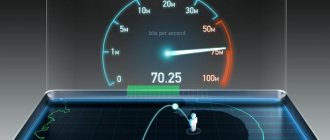We rarely think about what our smartphone is stuffed with. Previously, we used it only for calls and SMS, but now smartphones have become smaller and faster than laptops and computers. Modern smartphones are rich in a variety of sensors and smart sensors that help us use the simplest functions. Sensors and sensors are very sensitive to external changes. Do you turn your smartphone horizontally and the screen orients itself with you? So, you should thank the gyroscope installed in your device. By the way, thanks to the gyroscope, VR and everything connected with it exist. We tell you how a gyroscope works, why it is needed, how to calibrate it on Android, and how a gyroscope differs from an accelerometer.
We tell you how the gyroscope works in a smartphone
What is a gyroscope
A gyroscope is a device that helps determine the position of the body in space. It was invented quite a long time ago, back in 1817, and is still widely used today. An analog gyroscope consists of a rotor-top rotating around a vertical axis, which changes its position in space, and the rotation speed of the top exceeds the speed of rotation of its rotation axis. Because of this, the top maintains its position regardless of forces acting from the outside. To accurately determine position in space, such simple devices are used in airplanes, rockets, quadcopters, tablets and smartphones.
From a baby top to space flights
Many scientific discoveries are based on observation of simple everyday things. Likewise, one of the important devices used in modern devices, the gyroscope, was born from an ancient children's toy known as a top. A strongly spun top, which maintains a vertical position even when exposed to external forces, has attracted the attention of scientists. Studying its properties, people of science thought about the practical application of the effect. The Englishman Isaac Newton, the Russian academician Leonard Euler, who published the work “The Theory of the Motion of Solid Bodies” in 1765, and other scientists were interested in the top.
The first mechanical gyroscopes appeared at the beginning of the 19th century. But it was not until 1852 that French physicist Leon Foucault proposed using a device to control changes in direction and gave it the name “gyroscope.” The first industrial gyroscope was created at the end of the 19th century; the Austrian engineer Ludwig Aubry came up with the idea of using it to stabilize the course of a torpedo.
The next step in the history of gyroscopy was the creation of a laser gyroscope. Preparations for its “birth” took almost the entire 20th century, because for this it was necessary to improve quantum physics and create new methods for processing materials. The development of laser gyroscopes began in the 1970s, and widespread use occurred in the 2000s. Today we are at the stage of development of a new generation of gyroscopes - solid-state wave and micromechanical.
Nowadays, gyroscopes are used in a variety of areas: to stabilize photo and video cameras, in mobile devices and game controllers, in firearms and robotics, in hoverboards and quadcopters, in navigation and control systems in aviation, on ships and in space. Modern gyroscopes based on MEMS technology can reach millimeter sizes.
How does a gyroscope work in a smartphone?
This is what a smartphone gyroscope looks like
The gyroscope in smartphones and other smart devices is very different from ordinary ones, although it performs the same function. Mechanical energy is converted into electrical energy, which is formed in the operating algorithm. In smart devices, the gyroscope is a moving substance that moves at an angle, changing the electrical capacitance of the capacitors associated with your smartphone's processor. The simplest version of a gyroscope looks like two movable units that change position and send a signal to sensors. When the device is rotated, the entire gyroscope moves, which sends a signal about the changed location. Thanks to this simple device, you can shake your smartphone and turn it over so that interesting features built into the operating system of your smartphone work. If you plan to use a VR device, such as glasses or a helmet, then the gyroscope will play an important role in this, tracking the turns of your head and directing the virtual gaze exactly where your gaze is directed. What else interesting does VR hide? Read our materials in Yandex.Zen - we write something that no one knows about yet!
A little historical background
The inventor of the device is considered to be German-born astronomer Johann Bonenberger. At the beginning of the 19th century, the device was massive. To give the reader an idea, the device was designed in the same way as a simple top.
A mechanism whose elements can rotate around 3 axes is called a gyroscope with 3 degrees of freedom. How a simple gyroscope works:
- this is a device with a stable axis of rotation;
- the force acting on the axis displaces it in a plane located perpendicular to the force vector.
At the beginning of the last century, the gyroscope was used on monorails. Russian inventor P.P. Shilovsky decided to use it in the automotive industry. Having translated his intentions into reality, he created a gyrocar - a two-wheeled car. The machine was balanced by the gyroscopic effect. The mechanism in this vehicle was located exactly in the middle, being able to deviate in both directions by 25 degrees. A pair of heavy pendulums were suspended to the left and right.
You can feel the maximum gyroscopic effect while riding a bicycle.
Based on the principle of operation, a distinction is made between mechanical and optical gyroscopes. Mechanical devices in the original design are used less and less in practice. Vibration sensors are a type of mechanical sensors. This category has gained significant popularity in high-tech portable devices.
How does a gyroscope differ from an accelerometer?
The accelerometer helps in gaming on a smartphone
If you like to play on your smartphone occasionally, then these two sensors make your life much easier. They are both designed to determine the position of the gadget in space. If the gyroscope calculates the angle of inclination of your smartphone relative to the surface, transmitting information to the operating system, then the accelerometer very accurately calculates acceleration . This is why our smartphones do a good job of pedometers. The data will be more or less accurate: you can try to compare it with the data from your smart watch or fitness bracelet, the differences will be insignificant. Modern smartphones have both a gyroscope and an accelerometer, which helps avoid accidental rotation of the screen when moving it. What other interesting things do you want to know about a smartphone? Write to us in Telegram chat!
What else to read: Which surveillance camera to buy for your home
New time
In the photo above you can see a mobile application that simulates an accelerometer.
The modern design of accelerometers allows them to be connected to on-board computers in cars, trains, airplanes and rockets. Thus, an absolute integral system is obtained. Its main task is to analyze the measurement of the acceleration indicator. Subsequently, the computer gives the appropriate command to adjust the work, and the speed of movement increases or decreases.
At this point, the use of accelerometer sensors has expanded beyond the transportation industry. This device has also begun to be installed in mobile phones, but in a slightly different form. It is the modern variation of the reduced device that will be discussed further.
How to check the gyroscope in a smartphone
Using 360 video, you can check the functionality of your smartphone
All modern smartphones are equipped with these sensors. But if you are interested in how they work, there is a great way .
- Open the YouTube app
- Search for any video that supports 360-degree viewing.
- Try spinning your phone. If the image changes relative to the angle of inclination, then the gyroscope is working normally
- If nothing changes, check to see if auto-rotate screen is turned off
- You can also test this sensor in augmented reality games. The simplest example is the game Pokemon Go
You can also check the availability and functionality of devices in the AIDA64 application. Install the application and receive information in the “Sensors” section about all installed components in your smartphone.
Viscous damping.
To dampen the output moment of force relative to the axis of a two-degree gyro unit, viscous damping can be used. The kinematic diagram of such a device is shown in Fig. 5; it differs from the diagram in Fig. 4 in that there is no counter spring and the viscous damper is increased. When such a device is rotated at a constant angular velocity around the input axis, the output moment of the gyroscope causes the frame to precess around the output axis. Subtracting the effects of inertial reaction (the inertia of the frame is mainly associated with only a slight delay in the response), this moment is balanced by the moment of the viscous resistance forces created by the damper. The damper moment is proportional to the angular velocity of rotation of the frame relative to the body, so the output moment of the gyro unit is also proportional to this angular velocity. Since this output torque is proportional to the input angular velocity (at small output frame angles), the output frame angle increases as the body rotates about the input axis. An arrow moving along the scale (Fig. 5) indicates the angle of rotation of the frame. The readings are proportional to the integral of the angular velocity of rotation relative to the input axis in inertial space, and therefore the device, the diagram of which is shown in Fig. 5 is called an integrating two-degree gyro sensor.
In Fig. 6 shows an integrating gyro sensor, the rotor (gyromotor) of which is enclosed in a hermetically sealed glass, floating in a damping liquid. The signal of the rotation angle of the floating frame relative to the body is generated by an inductive angle sensor. The position of the float gyroscope in the housing is determined by the torque sensor in accordance with the electrical signals received by it. Integrating gyro sensors are usually mounted on elements equipped with a servo drive and controlled by gyroscope output signals. With this arrangement, the torque sensor output signal can be used as a command to rotate an object in inertial space. see also
GYRO-COMPASS.
How to calibrate the gyroscope on Android
The gyroscope is an independent sensor that cannot be configured independently. All smartphones have it and you can’t , it always works. In this situation, it is only possible to configure or calibrate the accelerometer. For example, enable or disable the screen rotation function.
Auto-rotate screen helps you avoid accidentally changing screen orientation
To calibrate the accelerometer, a third-party application, Accelerometer Calibration, is used. The mobile device is placed on a flat surface, and when the ball indicating balance is in the sight, you need to press the “Calibrate” button.
The gyroscope is one of the most important sensors along with the light sensor. It helps you navigate by changing the position of your phone. Without it, auto-rotate the screen would not work,
Disadvantages of the gyro sensor
Phones with a free gyroscope have not only advantages. The downside is the high sensitivity of the gyroscope to the movements of the smartphone. This makes it difficult to use some applications. For example, a user moved a phone with a sensitive sensor while reading. This will instantly change the position of the display. You will need to move the device in the opposite direction to return the screen to its original state.











